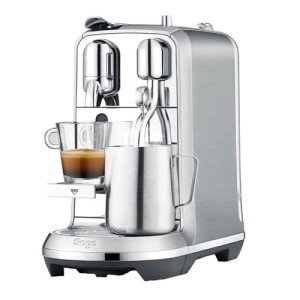The Art of Italian Espresso Machines : A Brewed Tradition
Italian espresso machines are not simply devices; they are an important part of Italy's abundant coffee culture, representing a mix of artistry, engineering, and style. Coffee aficionados all over the world recognize the value of high-quality espresso, a staple of Italian life and food. This article checks out the history, mechanics, types, and elements to consider when purchasing an Italian espresso machine, reflecting the depth of this precious drink and its developing methods.
History of Espresso Machines
The espresso machine's development dates back to the early 20th century in Italy, where coffee was not merely a beverage but a vital social ritual. The preliminary attempts to brew espresso started with basic, stove-top models, slowly progressing into complicated machines that might reproduce the ideal brew.
- 1901-- The First Espresso Machine: The first steam-powered espresso machine, called the "Ideale," was established by Luigi Bezzera. This machinery marked a turning point in espresso developing.
- 1938-- The Lever Machine: The introduction of the lever machine made it easier to manage the pressure used in espresso extraction, enhancing taste consistency.
- 1947-- The Automatic Machine: Reaching more consumers, Gaggia launched the very first automatic espresso machine, additional popularizing espresso bars.
- 2007-- The Digital Age: Technological improvements caused the birth of fully programmable machines, permitting users to personalize their developing settings to accomplish a personalized coffee experience.
Key Features of Italian Espresso Machines
Italian espresso machines embody precision, craftsmanship, and development. Here are some crucial elements that highlight their significance:
| Feature | Description |
|---|---|
| Boiler Type | Identifies how heat is generated and preserved. Typical types consist of single boiler, dual boiler, and heat exchanger. |
| Group Heads | Where the coffee is brewed; commercial machines often have multiple group heads for performance. |
| Pressure Control | Vital for accomplishing the ideal espresso; most machines operate at 9 bars of pressure. |
| Frothing Capabilities | The steam wand permits milk frothing, necessary for drinks like cappuccino and latte. |
| Build Quality | The materials used (stainless-steel, brass, etc) impact durability and heat retention. |
Kinds Of Italian Espresso Machines
Selecting the ideal machine depends upon user preferences, budget, and intended use. Below are the main kinds of Italian espresso machines:
Manual Espresso Machines
- Pros: Offer full control over the brewing procedure, permitting for an individualized touch.
- Cons: Require ability and practice, can be labor-intensive.
Semi-Automatic Machines
- Pros: Provide a balance in between automated and manual procedures; users manage water circulation.
- Cons: Can have a steeper knowing curve than completely automatic machines.
Completely Automatic Machines
- Pros: Simplify the brewing procedure with push-button operations; perfect for newbies.
- Cons: May sacrifice a few of the nuances of manual brewing.
Super-Automatic Machines
- Pros: Grind, tamp, brew, and froth instantly; convenient for hectic way of lives.
- Cons: Less control over the developing variables, potential for a less genuine espresso experience.
Buying Guide: Factors to Consider
Picking the perfect Italian espresso machine can be challenging, but considering the following aspects can simplify the decision-making process:
- Budget: Italian espresso machines range from affordable to high-end designs, so set a budget upfront.
- Use Frequency: Evaluate how frequently you will use the machine; daily users might want a more resilient alternative.
- Area: Measure your kitchen or counter area; some machines can be big and require sufficient clearance.
- Maintenance: Consider ease of cleaning; machines with removable parts or integrated cleansing functions might reduce upkeep.
- User Skill Level: Beginners may choose fully or semi-automatic machines, while skilled baristas can deal with manual machines.
- Brand Reputation: Research brands understood for quality, such as Breville, Gaggia, and La Marzocco.
Popular Italian Espresso Machine Brands
Italian workmanship is renowned for producing a few of the very best espresso machines worldwide. Here are top brands worth thinking about:
- Gaggia: Known for its home espresso machines and affordability.
- La Marzocco: A superior brand name known for its commercial-grade machines and innovative innovation.
- Rancilio: Renowned for its resilient construct and professional-quality machines suitable for home and commercial use.
- Sage/Breville: Offers advanced functions and user-friendly designs, best for both beginners and enthusiasts.
FAQs
What is the distinction in between espresso and routine coffee?
Espresso is a concentrated coffee brewed by forcing warm water through finely-ground coffee under pressure. It has a thicker consistency, richer taste, and greater caffeine concentration than regular coffee.
Can I make milk-based beverages with an espresso machine?
Yes, numerous Italian espresso machines come with a steam wand to froth milk for beverages like cappuccinos, lattes, and macchiatos.
How typically should I clean my espresso machine?
Routine upkeep is important. Normally, an extensive cleansing is suggested every couple of weeks, while descaling ought to be done every 1 to 3 months, depending upon water hardness.
What is the ideal pressure for developing espresso?
The perfect pressure for developing espresso is around 9 bars. This pressure guarantees the optimal extraction of tastes from the coffee grounds.
Are more expensive machines worth the financial investment?
Higher-end machines frequently utilize better materials and technology, supplying enhanced sturdiness and more consistent outcomes. For serious coffee enthusiasts, buying a great machine can elevate the espresso experience significantly.
Italian espresso machines are far more than mere developing devices; they are a celebration of a cultural custom that has influenced coffee consumption worldwide. With various designs available to fit any user's needs-- varying from novices to experienced baristas-- there is an Italian espresso machine completely fit for everyone. As you embark on your espresso journey, comprehending the history, mechanics, and options will enrich your experience and appreciation for this time-honored beverage. Whether you seek to recreate a coffee shop atmosphere in the house or improve your developing method, these machines can delivering memorable cups of espresso decorated with the rich history of Italian coffee culture.

